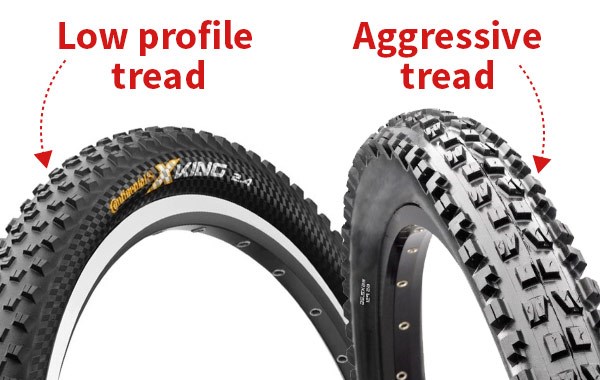Overview
As your only contact point with the ground, the right mountain bike tyre can make a huge difference to your performance on the trail. With trail conditions varying in different locations and at different times of the year, choosing the best MTB tyre is not always obvious. In this MTB tyre guide, we break down the most important aspects, like tread pattern and tyre width to help you choose the perfect tyre for the trails that you love to ride.
Size
MTB tyres are measured by their width alongside the size of the rim that it is designed to fit. See our tyre size guide to learn more about specific tyre sizing. The conventional wisdom is that wider tyres offer more grip, as they have a more rubber in contact with the ground, while narrower tyres roll quicker as there is less rolling resistance. While this is true for MTB wheel/tyre combinations that have the same diameter, mountain bikes are available with different wheel sizes. A 29er rolls significantly quicker than a bike with smaller 27.5” wheels if they have the same width tyres fitted. This means that we need to think about wheel size as well as tyre size. Our bike wheel size guide explains this in more detail.

Wider tyres have a larger volume which increases the overall diameter of the wheel. This means that the extra drag caused by the larger contact patch is offset by the increased speed offered by the larger diameter. This is why Plus sized tyres roll quickly despite their wide profile. One other thing to consider is that a narrower tyre will cut through mud to find grip while a wider one may tend to slide over it. This is why dedicated mud tyres are narrower than an equivalent tyre designed for rocky conditions.
Tread
Tread pattern makes a huge difference to the performance of a mountain bike tyre. Generally speaking, the smaller and more tightly packed the knobs on the tyre, the faster the tyre will roll but the less grip it will offer. Grip is essential, but the amount you require will vary depending on the specific trail surface you’re riding on. A low-profile tread pattern like that found on the Continental X King will give you plenty of grip on hardpack trails, but you will need the bigger knobs of a more aggressive tyre - like the Maxxis Minion - to find grip on loose surfaces. Tyre choice is always a balance between grip and straight-line speed, and the best tyre tread pattern will be different for different riding styles as well as different trail conditions.

An important consideration for UK riders, particularly if you like to ride natural trails, is how well the tyre can clear mud. If your tyre clogs up with mud easily you will lose grip more often, so dedicated mud tyres - like the Specialized Storm Control or Maxxis Shorty - have spike-like knobs with wide gaps between them to stop mud clinging to the tyre.
While choosing a tyre for specific conditions is essential for racers, most mountain bike trail riders don’t want the hassle of changing their tyres before every ride. This is where a good all-rounder comes in. A tyre with a relatively open tread pattern, reasonably sized mid-tread and aggressive side knobs - like the Maxxis High Roller - offers the ideal balance between grip and rolling resistance without clogging up with mud in the wet.

Compound
The rubber on your tyres gives you grip by conforming to the lumps and bumps of the surface you are riding on. This means that a softer rubber compound will offer more grip than a harder compound. For the same reasons, a soft compound will be slower rolling than a hard compound. As with most things mountain bike related, there is always a compromise between speed and grip, so the ideal tyre compound will vary depending on the type of terrain you ride on. Soft compounds are preferable for downhill racing while harder compounds are a better choice for long distance cross-country rides.
Another thing to consider is durability. Soft rubber compounds wear considerably quicker than hard rubber compounds, especially in the centre of the tyre as it spends most time in contact with the ground. To take account of this, some premium tyres are made from multiple compounds, with harder compounds in the centre for improved durability and speed, and softer compounds on the side for improved cornering grip.
In an attempt to maximise grip and speed as well as longevity, some high-end tyres features special rubber compounds that combine synthetic materials with natural rubber, to improve grip and durability without negatively impacting rolling resistance. One of the best examples of this is Continental’s Black Chili compound which features nanometric carbon soot particles for improved all-round performance.
Protection
Mountain bike tyres need to be tough enough to cope with hard riding on challenging terrain. For this reason, mountain bike tyres are tougher than road tyres. Unfortunately making a tyre tough also makes it heavy. There is always a trade-off between weight and toughness. Cross-country race tyres are the lightest but are not recommended for anything other than racing due to a lack of durability. Downhill tyres are the toughest, with double thickness sidewalls to reduce the chance of getting a flat when the tyre pinches against the rim. These tyres are too heavy for efficient trail riding however.
In order to improve durability without adding too much weight, tyre manufacturers add tough abrasion resistant layers to their high-end tyres. Side walls are particularly vulnerable to cuts from rocks. Premium MTB trail tyres feature sidewalls reinforced with a lightweight abrasion resistant layer that protects the sidewalls of the tyres from cuts. Look for Specialized GRID, Schwalbe Evo, Continental Apex or Maxxis Exo tyres for the best side wall protection.
Tubeless
With their vastly improved puncture resistance, Tubeless tyres are fast becoming the norm on mountain bikes. When used with tubeless tyre sealant, small punctures will seal themselves without you noticing. Even larger punctures are easy to fix on the trail, as you don’t even need to take the wheel off the bike. See our tubeless repair video to learn how to repair a tubeless MTB tyre
Another advantage of tubeless tyres is that you can reliably run lower tyre pressures. This gives you more grip without the pinch puncture risk you get with inner tubes. While they take a little more effort to set up initially, this extra work is more than offset when you realise that punctures are almost a thing of the past. Converting to tubeless tyres is easy. Tubeless compatible tyres are often labelled ‘Tubeless Ready’.
Weight
Alongside wheel weight, tyre weight is probably the most important weight consideration on a bicycle. This is because of the rotational effect of the wheel which means that adding weight to the rim will slow you down more than adding weight anywhere else. You will notice the effect of a heavy tyre most climbing and accelerating, so is the first place to look when you want to make your bike lighter. The easiest way to reduce tyre weight without compromising performance is to choose a tyre with a folding bead. Folding tyres use a Kevlar bead instead of a traditional steel bead which is just as strong, but much lighter.
Tyre Pressure
One of the simplest ways to improve the performance of your mountain bike is to ride with the right tyre pressure. The ideal tyre pressure will vary depending on riding style, rider weight, and trail surface. You want your tyres to be soft enough to conform to the lumps and bumps on the trail, but not so soft that you bang your rims on rocks and roots, or the tyre folds over and squirms about while cornering.
If you are riding cross country trails or a trail centre loop, then you will want your tyre to be hard enough for efficient rolling on the climbs but not so hard that you loose grip on the downhills. For aggressive downhill riding lower pressures are ideal as they will give you more grip. Downhill tyres tend to have thicker reinforced side walls that help to prevent pinch punctures and give you additional support while cornering. Another consideration is that a higher-volume tyre will require less pressure than a thinner tyre for optimal performance.
There are too many variables to give an ideal pressure range here, but most mountain bikers will run between 20psi and 40psi. Lighter riders will benefit from lower tyre pressures, while heavier bikers will need higher pressures to get the right level of support from the tyre. Mountain bikers tend to run a couple of psi more in the back than the front, as it is the rear tyre that takes the biggest hammering. A simple rule of thumb is never to exceed the recommended tyre pressure, found on the tyre side wall, but don’t be afraid to experiment with lower tyre pressures, especially if you are running a tubeless set-up. A digital pressure gauge or digital track pump is the most accurate way to measure tyre pressures, while a hand pump with a pressure gauge is the least accurate, but can be very helpful out on the trail.
You will need to check what wheel size you have along with the clearance given by your frame and fork. The tread of a tyre will depend on the conditions you ride in. For example, a tyre with a smooth tread will roll faster but have less grip on loose surfaces, while a knobbly tyre will give better grip but roll slower on smooth surfaces.
A traditional road tyre will often be too narrow for the rims found on mountain bikes. There are hybrid tyres available to fit mountain bike-sized wheels that have a smooth fast-rolling tread that will give much better performance on the road over an MTB tyre.
A wide mountain bike tyre will conform more easily to uneven ground and rocky surfaces. A wide tyre will have more volume that allows the rider to run a lower pressure again contributing to grip.
You might be able to fit wider tyres to your bike. Please look at your fork and frame to check the clearance given, then remove around 5mm each side to give your maximum allowance for tyre width. The 5mm minimum clearance allows for some mud clearance. If you ride in particularly muddy conditions, more mud clearance will be needed.
Yes, hybrid tyres come in many different sizes and widths, there are many available for the size of wheels found on mountain bikes.
While traditional narrow road bike tyres are not suitable for mountain bikes, hybrid tyres can be fitted. If riding on roads and smooth paved surfaces, a hybrid tyre will make a dramatic difference to your mountain bike by having much less drag than a mountain bike tyre.





